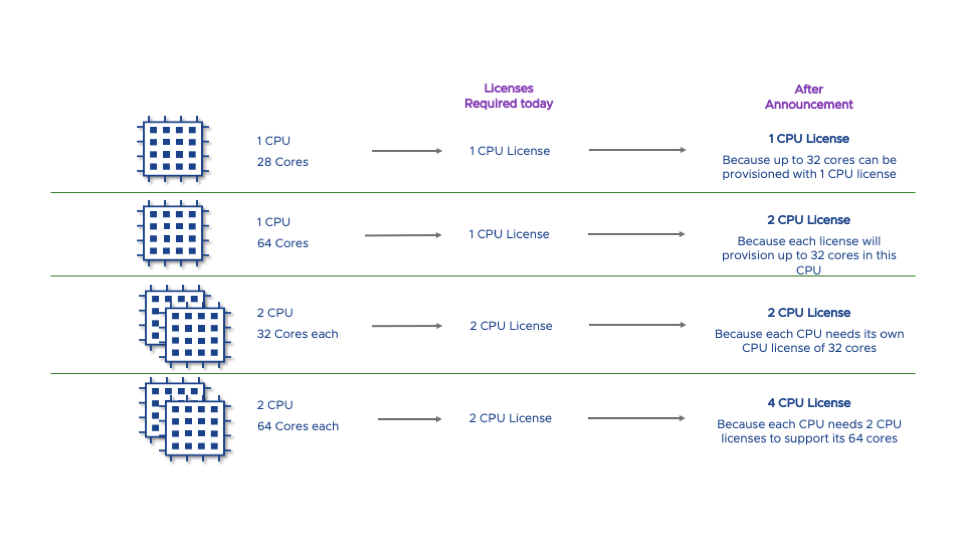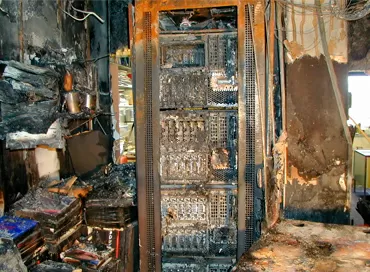Freebies will not be! VMware waives the license for the socket
I hope you had time to enjoy how your new 1-socket server on AMD EPYC smartly replaces 2 or even 4 old servers on Xeon E5, and at the same time you deduct a mere penny for the hypervisor license? The freebie is over: now VMware changes the license policy, considering that there are no more than 32 cores in 1 socket.
How good was it before?
Previously, when you purchased VSphere, you paid a license fee for each physical processor. If you have 1 processor with 2 cores, or 1 processor with 64 cores, the price was the same. If you have 2 or 4 processors in the server, the price increased by 2 or 4 times, respectively.
|
Comparison of software licensing costs for selected servers
|
||
|
|
1 x AMD EPYC (HPE ProLiant DL325 Gen10 4LFF) |
2 x Xeon Platinum (HPE ProLiant DL360 Gen10 4LFF) |
|
Citrix Hypervisor Standard Edition |
763 $ |
1526 $ |
|
Citrix XenServer Enterprise Edition |
1525 $ |
3050 $ |
|
Red Hat Virtualization with standard support |
2997 $ |
2997 $ |
|
Red Hat Virtualization with additional support |
4467 $ |
4467 $ |
|
SUSE Linux Enterprise Virtual Machine Driver, Unlimited |
1890 $ |
3780 $ |
|
VMWare vSphere Standard with standard support
|
1847 $ - before 3694 $ - after
|
3694 $ |
|
VMWare vSphere Standard with additional support
|
5 968 $ - before 11 937 $ - after
|
11 937 $
|
The main beneficiaries of this licensing policy were Intel and AMD, which introduced multi-core Xeon Scalable and EPYC processors for Cloud platforms. Later in the core race, AMD took a significant lead, managing to place as many as 64 physical cores in one socket, while Intel was stuck on 28 cores. AMD's audacity in advertising 1-processor servers instead of 2-processor servers must have provoked the wrath of the gods, and now VMware's licensing policy is different.
How is it now?
Now the license takes into account not only physical processors, but also their physical cores (thanks for not taking into account logical ones due to Hyper Threading), and the limit for one socket is 32 cores. That is, if you have a 32-core processor, then nothing changes for you, you both paid for 1 socket, and you will, but starting with 48 cores, there is already a fee for 2 sockets.

If you have 2 processors with 64 cores each, you will have to pay for a license for 4 sockets.
When does it take effect?
April 30, 2020. Those who purchased a 1-secret license for a processor with more than 32 cores before April 30, 2020, will receive a free license for the second socket.
Who will benefit from the innovation?
First of all, the winner is VMWare, which will be able to increase its revenue from software. Moreover, I want to note that this company has rather weak compatibility with AMD processors: only EPYC is officially supported, and bugfixes are constantly released for the Rome core, and some of them require updating AGESA (processor microcode via BIOS). Excellent in all respects EPYC 3000, which is twice as fast, cooler and cheaper than the similar Xeon, is not supported, but it works.
At the same time, Intel does not benefit from the new licensing policy: the company suffers from supply problems, the inability to curb the new technical process, almost daily security problems, and a deep technological gap with AMD EPYC Rome processors. You understand that the same people who buy home Ryzen and see how good It is already have a keen interest in EPYC and are wary of Xeon Scalable.
Citrix with a software-based license will win in some ways, and Linux platform vendors, from Red Hat and SUSE to local companies like Alt Linux and Astra Linux, will win in some ways: their portfolio of arguments like "remove CIA software from our data centers!" now adds an amazing epithet: "they will want to-and will inflate your price twice, and you will continue to suffer!". In general, if anyone was going to switch from VMware to Linux, now is the time.
Who will lose from this innovation?
The only company to whom this innovation "out of the blue" is AMD. In our article about migrating from Xeon to EPYC, we showed that the price difference between an AMD server and an Intel server, including software, can be almost twofold. This is crazy, but not the only advantage of AMD processors that no one wanted to lose. The EPYC 7552 processors are left out. when you buy them, you pay a license for 64 cores, and you use 48 cores. Perhaps they will be sold at a discount or completely disappear from the AMD model range. There is nothing to say about Huawei yet, since Kunpeng 920 is not supported by VMWare, and all this does not concern free Chinese.
A friend of mine who is close in spirit to AMD integration said: "well, not ESXi unified", and noting in the calendar on April 30, went to meet the growth of orders for EPYC-and.
Who is to blame?
If you will find graphs of the number of cores in the processor, you will see that to architecture AMD Napples, industry stood still: well 4, well 8 cores in the CPU, usually the brakes on his head. There were 4-node 2U servers with 8 processors each, but only 32 or 64 cores per machine.

source: servethehome.com
Now, the number of cores in the processor tends to double from generation to generation, and even arm-solutions Huawei Kunpeng 920, a review of which will soon appear on our website, have 48 cores per socket. People change four old servers to one new one, and where VMware sold 8 licenses, It now sells one, and the trend tends to continue. No one wants to lose money, and VMware was one of the few who used a software-based license.
How will this affect the world as a whole?
For the IT sphere, the saying is true as for no other: "Either you're smart or you pay," and VMware customers are large enterprises with huge expenditures on the means of production, including rent, salaries, and marketing, unable to support expensive specialists, but resorting to the services of outsource companies. IT infrastructure in General and the license for hypervisors in particular for such customers is a drop in the bucket. Usually, they need someone to blame for a security breach, someone to come and wipe the system administrator's snot if the car fell into the PSOD and does not rise, and a personal Manager, integrator, and SLA. As soon as you take into account a company that buys and sells IT services or IT products, there are enough specialists who can work on free software. Examples of this are Google and Hetzner... a little something?
Do not forget that with all the convenience and popularity of VMware ESXi, it is not the most expensive software product, especially if you compare it with Microsoft Windows Server Datacenter Edition, Oracle programs or specialized software for development.
Also, do not forget that if the price of a hypervisor is crucial for someone, then there are free CentOS and Debian operating systems in the world that are better compatible with hardware than VMware ESXi, are better documented and are audited for the absence of bookmarks and backdoors.
And most importantly, more and more services are being moved to Kubernetes containers, which is another advantage of the Linux architecture.
What should I do now?
We sat down, exhaled, calmed down and asked ourselves the question: what additional costs will your company incur from the presence of Vendor Lock in your IT infrastructure? Count all the licenses for the socket that you use and without any illusions, estimate on your knee how much it will cost to switch to a license for the core. You don't think that Suse and Citrix will stay on the sidelines and not go for a higher price? If the fee for Vendor Lock fits into the growth of production costs - relax and don't worry about anything.
If the risks of this state of Affairs are too high, we give up annoying vendors as bad habits: from a single CPU supplier, from hardware consolidated storage, from proprietary operating systems, databases, office, browser, messenger. In today's multipolar world, it is too stupid and too expensive to depend on anyone.
Michael Degtjarev (aka LIKE OFF)
05/02.2020













